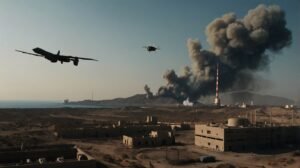
Introduction
The tensions between Iran and Israel have escalated dramatically over the past few years, creating a volatile situation that threatens to destabilize the entire Middle East region. The historical animosity between these two nations has intensified, leading to a series of confrontations marked by drone strikes, air raids, and proxy wars. As the conflict evolves, its repercussions extend beyond the borders of Iran and Israel, impacting oil markets, shipping routes, and the geopolitical landscape of the region.
In this article, we will explore the timeline of escalations between Iran and Israel, the implications for oil markets and shipping in the Strait of Hormuz, and the reactions of key players in the region, including Saudi Arabia, Turkey, and Gulf states. We will also delve into the dynamics of proxy warfare in Syria, Lebanon, Iraq, and Yemen, as well as the diplomatic maneuvers of the United States and the European Union. Furthermore, we will address the nuclear threat posed by Iran and the involvement of the International Atomic Energy Agency (IAEA). By incorporating personal stories and human experiences, we aim to humanize the conflict and highlight the resilience of those affected by the ongoing tensions.
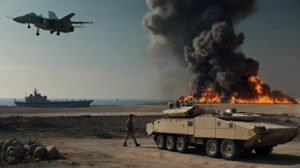
Timeline of Escalations
Early Hostilities
The roots of the Iran-Israel conflict can be traced back to the 1979 Iranian Revolution, which led to the establishment of an Islamic Republic that vehemently opposes Israel’s existence. Over the decades, tensions have simmered, but a series of incidents have escalated the situation into open hostility.
– **2010**: The Stuxnet cyberattack, widely attributed to Israel, targets Iran’s nuclear facilities, marking the beginning of a covert war between the two nations. This cyber assault effectively disrupts Iran’s nuclear program, showcasing the lengths to which Israel will go to thwart Iranian ambitions.
– **2012**: Israeli officials voice increasing concerns about Iran’s nuclear program, warning that Iran is on the brink of acquiring nuclear weapons. This period sees heightened rhetoric and a series of military drills by Israel, showcasing its readiness to act.
– **2015**: The Joint Comprehensive Plan of Action (JCPOA) is signed, temporarily easing tensions by limiting Iran’s nuclear capabilities in exchange for sanctions relief. However, the agreement’s collapse in 2018, following the U.S. withdrawal, reignited hostilities.
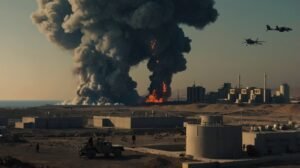
Recent Escalations
2020: The Assassination of Qasem Soleimani
In January 2020, the U.S. assassination of Iranian General Qasem Soleimani in Baghdad heightened tensions further. Soleimani was a key figure in orchestrating Iran’s influence across the region, leading to a vow of retaliation from Iran, which promises to avenge his death. This assassination not only escalates U.S.-Iranian tensions but also exacerbates the hostility between Iran and Israel, as Soleimani had close ties with Hezbollah and other militant groups.
2021: Drone Strikes and Air Raids
Throughout 2021, both Iran and Israel engaged in a series of drone strikes and air raids that targeted military installations and personnel. Israeli airstrikes on Iranian positions in Syria become increasingly frequent, while Iran ramps up its support for proxy groups in the region.
– **May 2021**: The conflict between Israel and Hamas escalates, with Iran providing support to Hamas and Islamic Jihad. This indirect confrontation showcases the broader implications of the Iran-Israel hostility, as violence spills over into Gaza and leads to significant casualties on both sides.
– **July 2021**: An Israeli drone strike targets an Iranian military site in Syria, killing several Iranian military advisors. In response, Iran vows to retaliate, leading to a series of tit-for-tat exchanges that further inflame tensions.
2022: Escalating Attacks
By 2022, the situation intensifies as Israel targets Iranian assets in Syria and Iraq, while Iran responds with drone strikes against Israeli shipping in the Gulf. The conflict escalates further, with both sides conducting retaliatory strikes that increase regional instability.
– **August 2022**: Israel executes airstrikes against Iranian-backed militias in Syria, killing several key figures. Iran threatens retaliation, signaling a dangerous escalation in hostilities. The cycle of violence seems unending as both countries remain committed to their respective strategies.
2023: Heightened Tensions
The year 2023 sees an increase in drone and airstrike exchanges between Iran and Israel. Iranian drones are intercepted over Israeli airspace, while Israel continues to target Iranian military installations in Syria and Iraq.
– **October 2023**: A significant air raid conducted by Israel targets an Iranian missile factory in Syria, resulting in widespread condemnation from Tehran. The cycle of retaliation continues, with both nations vowing to escalate their responses. The international community watches closely, fearing a broader regional conflict.
This timeline of escalations highlights the precarious nature of the Iran-Israel conflict, where each incident has the potential to trigger a larger regional confrontation.
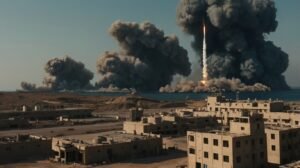
Impact on Oil Markets and Strait of Hormuz Shipping
The Strategic Importance of the Strait of Hormuz
The Strait of Hormuz is a crucial waterway through which approximately 20% of the world’s oil supply passes. Given its strategic importance, any conflict in the region has immediate repercussions for global oil markets and shipping routes. The ongoing hostilities between Iran and Israel place this vital passage at risk.
Oil Prices and Market Reactions
Whenever tensions escalate in the region, oil prices tend to spike due to fears of supply disruptions. The impact on oil markets is immediate and pronounced:
– **2021**: Following a series of drone strikes by Iranian forces on oil tankers in the Gulf, oil prices surge as traders react to the perceived risks associated with shipping in the Strait of Hormuz. The fear of conflict affects not only the oil supply but also global economic stability.
– **2022**: Israel’s airstrikes on Iranian facilities lead to further concerns about potential retaliation, resulting in a spike in oil prices as global markets react to the uncertainty. Analysts predict that sustained conflict could lead to even higher prices, affecting consumers worldwide.
The volatility in oil prices not only affects consumers and businesses but also has broader implications for economies around the world. Countries heavily reliant on oil imports face increased costs, which can lead to inflation and economic instability.
Shipping Disruptions
As tensions rise, shipping routes through the Strait of Hormuz become increasingly perilous. Shipping companies may choose to reroute vessels, leading to longer transit times and increased shipping costs. The potential for military confrontations in the area raises fears of maritime security threats, prompting nations to enhance their naval presence in the region.
Local fishermen and small-scale shipping operations also bear the brunt of the escalating tensions. A fisherman from Oman, Ahmed, shares his experience: “The waters have become dangerous. We worry about our safety and the future of our livelihoods. Tensions between Iran and Israel affect us all, even those of us who are just trying to make a living.”
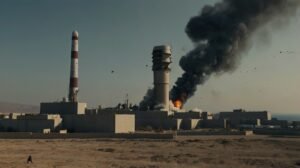
Economic Impact on Regional Allies
The ongoing conflict also affects neighboring countries economically. Nations like Saudi Arabia, the United Arab Emirates, and Qatar, which are heavily reliant on oil exports, feel the pressure of fluctuating oil prices.
– **Saudi Arabia**: As a leading oil producer, Saudi Arabia is particularly vulnerable to the economic repercussions of rising oil prices. The Kingdom’s economy is heavily dependent on oil revenues, and any disruption in supply can have significant implications for its budget and economic stability.
– **United Arab Emirates**: The UAE’s strategic location and its status as a global trade hub make it sensitive to shipping disruptions. The potential for increased military activity in the Gulf raises concerns for business leaders and investors.
– **Qatar**: While Qatar has a diversified economy, the country still relies on energy exports. Heightened tensions can impact its LNG exports, which are vital for its economic growth and development.
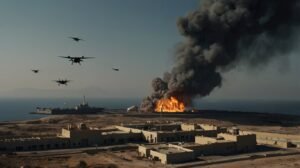
Reactions from Saudi Arabia, Turkey, and the Gulf States
Saudi Arabia’s Position
Saudi Arabia has historically viewed Iran as a rival, with the two nations competing for regional influence. The escalation of hostilities between Iran and Israel raises concerns in Riyadh, prompting the Kingdom to reassess its strategic posture.
Diplomatic Maneuvers
Following the assassination of Soleimani, Saudi Arabia increased its military readiness and engaged in diplomatic efforts to strengthen ties with the United States and other Gulf states. The Kingdom remains wary of Iran’s growing influence in Iraq, Syria, and Yemen, where Iranian-backed militias operate.
A senior Saudi official expresses, “We cannot afford to ignore the threats posed by Iran. Our security depends on countering their influence across the region.” This sentiment is echoed by many policymakers in Riyadh, who see the Iranian threat as a direct challenge to their sovereignty.
Turkey’s Involvement
Turkey, under President Recep Tayyip Erdoğan, has taken a more assertive role in regional affairs. The country has historically supported Palestinian groups, including Hamas, and has condemned Israeli actions in Gaza.
Balancing Act
Turkey’s position is complex, as it seeks to expand its influence while maintaining relationships with both Iran and Israel. Diplomatic engagements in the region highlight Turkey’s ambitions to play a more significant role in Middle Eastern geopolitics.
A Turkish diplomat, who prefers to remain anonymous, shares insights: “We must navigate these waters carefully. While we support the Palestinian cause, we also recognize the need for stability in the region. The Iran-Israel conflict complicates our efforts.”
Gulf States’ Concerns
Gulf states, including the United Arab Emirates and Bahrain, have expressed concerns regarding the potential fallout from the Iran-Israel hostilities. The normalization of relations with Israel through the Abraham Accords has shifted the dynamics in the region.
Strategic Alliances
Gulf states are increasingly aligning themselves with Israel in response to perceived Iranian threats. The potential for collaboration on security and intelligence sharing raises questions about the evolving alliances in the region.
A senior official from the UAE comments: “We recognize the threats posed by Iran’s aggressive behavior. Strengthening ties with Israel enhances our security and stability in an increasingly unpredictable environment.” This shift marks a significant change in the regional balance of power.
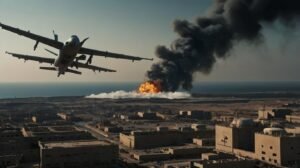
Proxy Warfare: Syria, Lebanon, Iraq, and Yemen
The Syrian Front
Syria has become a battleground for proxy warfare, with Iran and Israel vying for influence. Iran has established a significant military presence in Syria, supporting the Assad regime and backing various militias.
Israeli Airstrikes
Israel has conducted numerous airstrikes targeting Iranian positions and weapons transfers in Syria. The goal is to prevent Iran from entrenching itself militarily on its northern border. These airstrikes have led to casualties among Iranian fighters and have heightened tensions further.
– **2022**: An Iranian military commander is killed in an Israeli airstrike in Syria, prompting vows of retaliation from Tehran. The ongoing conflict in Syria complicates the situation, with various actors involved and humanitarian crises unfolding.
Lebanon: The Hezbollah Factor
Hezbollah, the Iranian-backed militia in Lebanon, serves as a key player in the proxy conflict. The group has engaged in skirmishes with Israeli forces along the border and has threatened to retaliate against Israeli strikes.
Escalating Tensions
The presence of Hezbollah complicates the situation, as any conflict involving Israel and Iran could quickly spill over into Lebanese territory. The group has significant military capabilities and has vowed to defend Iranian interests in the region.
A Hezbollah fighter, who wishes to remain anonymous, states: “We are prepared to respond if Israel continues its aggression. Our commitment to Iran and the Palestinian cause is unwavering.” This sentiment reflects the deep-rooted loyalties and ideological commitments that fuel the conflict.
Iraq and Yemen: Regional Dynamics
In Iraq, Iranian influence has grown through various militias, leading to tensions with U.S. forces stationed in the country. Iranian-backed militias have targeted U.S. bases, further complicating the security landscape.
In Yemen, the Iran-aligned Houthi movement continues to engage in conflict with Saudi Arabia. Proxy warfare in Yemen serves as another front in the broader Iran-Saudi rivalry, with implications for regional stability.
– **2023**: The Houthis conduct missile strikes against Saudi targets, prompting retaliatory airstrikes from the Saudi-led coalition. This ongoing conflict exacerbates the humanitarian crisis in Yemen, where millions face starvation and displacement.

U.S. and EU Diplomatic Maneuvers
The Role of the United States
The United States plays a significant role in the Iran-Israel conflict, with its historical support for Israel and its efforts to counter Iranian influence in the region. The assassination of Qasem Soleimani marked a turning point in U.S. policy, leading to increased military presence in the region.
Diplomatic Efforts
U.S. officials have engaged in diplomatic efforts to de-escalate tensions, often emphasizing the importance of dialogue between Iran and Israel. However, the complexities of the situation, coupled with domestic political considerations, have made it challenging to achieve meaningful progress.
A U.S. diplomat states: “We are committed to ensuring the security of our allies in the region. However, we also recognize the need for dialogue. The situation is delicate, and any miscalculation could lead to devastating consequences.”
European Union’s Involvement
The European Union has sought to mediate tensions between Iran and Israel, emphasizing the importance of diplomacy in addressing the nuclear threat. The EU’s involvement in the JCPOA was a significant step toward easing tensions, but its collapse has raised concerns.
Balancing Interests
The EU must balance its relationships with Israel and Iran while addressing the broader implications of the conflict for regional stability. European leaders have expressed concerns about the humanitarian impact of the conflict and the potential for further escalation.
An EU official comments: “Our goal is to promote stability in the region. We cannot afford to ignore the humanitarian consequences of the ongoing hostilities. Dialogue remains essential.”
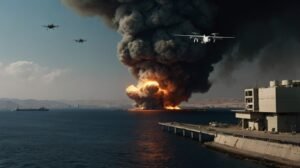
The Nuclear Threat and IAEA Involvement
Iran’s Nuclear Ambitions
Iran’s pursuit of nuclear technology has long been a point of contention, with Israel and the U.S. expressing concerns about the potential for Iran to develop nuclear weapons. The nuclear program is seen as a direct threat to Israel’s national security.
IAEA’s Role
The International Atomic Energy Agency (IAEA) plays a crucial role in monitoring Iran’s nuclear activities. The agency’s reports provide insights into Iran’s compliance with nuclear agreements and its intentions.
– **2023**: The IAEA issues a report expressing concerns about Iran’s nuclear advancements, prompting calls for renewed negotiations. The agency’s involvement is critical to ensuring transparency and accountability in Iran’s nuclear program.
The Path Forward
As tensions continue to escalate, the threat of a nuclear-armed Iran remains a pressing concern. Diplomatic efforts to address this issue are essential to prevent further conflict. The IAEA’s involvement is critical in ensuring transparency and accountability within Iran’s nuclear program.

Humanizing the Conflict
Personal Stories of Resilience
Amid the geopolitical complexities and hostilities, the human cost of the Iran-Israel tensions is often overlooked. Individuals and families on both sides of the conflict endure profound hardships and challenges.
Stories from Israel
In Israel, the threat of rocket attacks from Gaza and Hezbollah looms large. Families live in constant fear of sirens blaring and the need to seek shelter. A mother from Tel Aviv, Sarah, expresses her anxiety: “Every day, I worry about my children’s safety. The sound of sirens is a reminder that we are always on edge.”
Another Israeli citizen, David, recounts how he has adapted to life in a conflict zone. “You learn to live with the anxiety, but it never goes away,” he says. “I just want my children to grow up in a safe environment, free from the fear of war.”
Voices from Iran
In Iran, citizens grapple with the consequences of their government’s actions. A young Iranian student named Amir shares his frustration: “I want peace, not war. We are tired of living under sanctions and in fear of conflict. We just want a chance to build a better future.”
Fatemeh, a mother from Tehran, echoes these sentiments, stating, “We are tired of being caught in the middle of power struggles. We want our children to know peace and stability, not fear and uncertainty.”
These personal stories highlight the resilience of individuals caught in the crossfire of geopolitics. They serve as a reminder that behind the headlines are real people facing real challenges.
The Impact on Communities
Communities on both sides of the conflict bear the brunt of the hostilities. Schools are disrupted, businesses suffer, and families are torn apart. The psychological toll of living in a conflict zone is profound, with mental health issues becoming increasingly prevalent.
Local organizations and humanitarian groups work tirelessly to provide support and assistance to those affected. In Israel, community centers offer counseling services and resources for trauma recovery. In Iran, grassroots organizations advocate for peace and promote dialogue among citizens.
Humanitarian Organizations in Action
Humanitarian organizations play a vital role in assisting those affected by the conflict. In both Israel and Iran, NGOs work to address the needs of communities impacted by the ongoing violence.
– **In Israel**: Organizations like the Israel Trauma Coalition provide mental health support and resources for children affected by rocket attacks. Programs focus on resilience-building and helping families cope with the psychological aftermath of conflict.
– **In Iran**: NGOs work to assist families affected by sanctions and economic hardship. Initiatives include educational programs for children and support for families struggling to make ends meet.

Conclusion
The fallout of the Iran-Israel tensions has far-reaching implications for the Middle East and beyond. As escalations continue, the impact on oil markets, shipping routes, and regional dynamics is undeniable. The responses of key players, including Saudi Arabia, Turkey, and Gulf states, further complicate the geopolitical landscape.
The ongoing proxy warfare in Syria, Lebanon, Iraq, and Yemen underscores the interconnectedness of conflicts in the region. Diplomatic maneuvers by the U.S. and the EU aim to address the challenges posed by the nuclear threat and promote stability, but the path forward remains fraught with obstacles.
Amid the turmoil, the human stories of resilience and hope remind us of the importance of dialogue and understanding. As we navigate the complexities of the Iran-Israel conflict, it is essential to prioritize the voices of those directly affected and work towards a future where peace and stability can prevail.
For further insights and analysis on global issues, visit zaroraterishta.com
Key FAQs on Iran-Israel Tensions (2024-2025)
-
Why are Iran and Israel in conflict?
Iran opposes Israel’s existence, supports anti-Israel groups (like Hamas and Hezbollah), and pursues nuclear capabilities, while Israel conducts preemptive strikes to counter these threats. -
How does this conflict impact global oil prices?
Tensions risk disrupting the Strait of Hormuz (20% of global oil supply), causing price spikes and shipping delays. Attacks on tankers or infrastructure could trigger a crisis. -
What’s the role of proxy wars in this conflict?
Iran backs groups like Hezbollah (Lebanon), Houthis (Yemen), and militias in Syria/Iraq to pressure Israel indirectly, while Israel strikes Iranian assets abroad. -
How are Saudi Arabia and the Gulf states reacting?
Gulf nations (e.g., UAE, Bahrain) now align with Israel against Iran but fear regional war. Saudi Arabia balances diplomacy with military preparedness. -
Could this escalate into a full-scale war?
Risk is high if direct Iran-Israel strikes occur (e.g., nuclear facilities or major cities). Miscalculations or failed diplomacy could ignite broader conflict. -
What’s the U.S. and EU’s stance?
The U.S. backs Israel militarily but pushes for de-escalation. The EU seeks diplomatic solutions, especially to prevent nuclear proliferation. -
How does Iran’s nuclear program factor in?
Israel views a nuclear-armed Iran as an existential threat. The IAEA monitors Iran’s compliance, but stalled negotiations heighten risks. -
What’s the humanitarian cost?
Civilians in Gaza, Lebanon, Syria, and Yemen suffer from war fallout—displacement, economic collapse, and trauma from constant strikes. -
Are there efforts to de-escalate?
Mediation by Qatar, Oman, or the UN is possible, but mutual distrust and hardline policies hinder progress. -
What’s the worst-case scenario?
A regional war drawing in Hezbollah, U.S. forces, and Gulf states, spiking oil prices to $150+/barrel and triggering global economic shocks.
